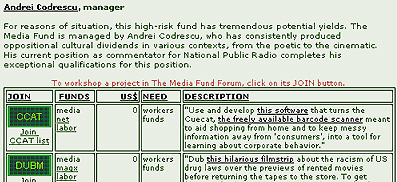|

David
Rieder
University of Texas at Arlington Extending this issue's focus on media literacy, I
wanted to highlight the work of an international collective of
tactical media practitioners whose projects have been the
increasing focus of conference presentations and scholarly
papers. The collective is post-disciplinary in focus and in
purpose, and its tactics support a wide range of cultural
expression from the aesthetic to the anarchistic. If media
literacy is typically concerned with representational
critique, these practitioners offer an alternative method.
Informed in part by Michel de Certeau's theory of tactics,
their methods are less concerned with representations than
with the use of representations. For these
practitioners, media literacy is a hybrid methodology of cuts
and disruptions into the flow of "spectacular culture." One of
their objectives is to open up local, temporary spaces for
alternative, not-for-profit modes of thinking and living.
In the introduction to their
book Digital Resistance: Explorations in
Tactical Media, from which the above quote is taken,
the Critical Art Ensemble (CAE) write, "the
tactical media practitioner uses any media necessary to meet
the demands of the situation. While practitioners may have
expertise in a given medium, they do not limit their ventures
to the exclusive use of one medium" (8). From a pedagogical
standpoint, media literacy is a local, pragmatic affair. De
Certeau likens it the ancient Greek art of sophistry.
Moreover, tactical media literacy is the work of amateurs. The
CAE explain:
|
Amateurs have the ability
to see through the dominant paradigms, are freer to
recombine elements of paradigms of thought long dead,
and apply everyday life experience to their
deliberations. (8) |
Due to their "inexpertise," collective
or group work is the staging point for the wide range of
critical expression. With a local focus and a pragmatic
philosophy towards the media, these practitioners are making
their work known around the world.
In this column, I will focus on the work hosted
on http://flansburgh.english.purdue.edu/twi/columns/tactical/.
®TMark is a self-described corporate
brokerage that "supports the sabotage (informative alteration)
of corporate products . . . by channeling funds from investors
to workers for specific projects." One of its distinguishing
characteristics is its appropriation of the corporate model of
the mutual fund to facilitate interaction among its users.
Importantly, ®TMark is non-violent. One of their
"bottom-line" criteria is "attack without physical injury."

On the FAQ for their site,
®TMark writes,
|
Project groupings called
"mutual funds" perform much the same function as their
financial counterparts: by facilitating investment based
on general areas of interest, they allow investors to
participate in unpredictable behavior without fully
understanding its nature or consequences. (par. 12)
|
There is a wide range of fund themes
many of which are managed by well-known groups or individuals
in alternative cultures. "The Frontier Fund" is managed by DJ
Spooky, That Subliminal Kid, "The High Risk Fund" is managed
by Heath Bunting, who works on irational.org, and "The Media
Fund" is managed by Andrei Codrescu, writer and commentator on
National Public Radio. Looking at a snapshot of
Codrescu's fund, the first project listed under development is
the CueJack.

The "CueJack" is a
downloadable software program that subverts the normal
operations of Digital Convergence's
well-publicized :CueCat. As you probably know, the
:CueCat is a handheld barcode scanner that directs
Internet users to official corporate homepages listed in Digital Convergence¹s database. The
CueJack subverts this action, redirecting users from
the official listings in Digital
Convergence's database to the results of a Lycos search query of publicized
corporate illegalities and inequities. If the corporation in
question has been boycotted, or if it has been charged with
corporate abuse, the CueJack's users will find out
about it. The CueJack, like many of the projects in
®TMark¹s funds, use
mainstream technologies against the corporations and agencies
that developed them. Spectacular culture is used against
itself in the name of critical awareness and cultural
transformation.
®TMark
also includes a list of past projects on its site. One that
received an impressive amount of press is vote-auction.com,
which can now be found at http://62.116.31.68/.
Developed for the 2000 presidential campaign, the site, like
the CueJack, is considered a piece of "parodyware."
Drawing attention to the extent to which corporate interests
drive the American electoral process, the site removes the
traditional middlemen (the political parties) from the voting
process, allowing voters to sell their votes directly to the
corporations that influence voter interest. Developed by a
student at Rensselaer Polytechnic Institute, the site received
a lot of attention from most major media outlets. In their
introduction to the site, ®TMark writes:
|
In article after article
and television spot after television spot, journalists
found ways to mention that corporations already purchase
American votes--exactly the issue that founder James
Baumgartner and owner-rescuer Ubermorgen.com intended
the website to highlight.
|
Today, the site is a piece of tactical
media history, but its developers claim that the concept
driving vote-auction.com will be used again. This project is
another example of the way in which a tactical media literacy
will work within the logic of mass media to create awareness
and possible change.
Outlining his theory of tactics, de Certeau
states, "a tactic boldly juxtaposes diverse elements in order
suddenly to produce a flash shedding a different light on the
language of a place and to strike the hearer" (37-38). In this
way, the media literacy that is derived from these
practitioners can be associated with the practices of collage
and montage in modern avant-garde art. By juxtaposing elements
that are typically separated in spectacular society, these
practitioners try to create pockets of awareness that are
unsupported by the mainstreams of society.
Works Cited
Baumgartner, James.
"[V]ote-auction: It's Different because It's Fundamentally
Different." 10 December 2001 http://62.116.31.68/.
Critical Art Ensemble. Digital Resistance:
Explorations in Tactical Media. Brooklyn: Autonomedia,
2001.
De Certeau, Michel. The Practice of Everyday
Life. Trans. Steven Rendall. Berkeley: University of
California Press, 1984.
"®TMark: Corporate Consulting for the 21st
Century." 10 December 2001. ®TMarkhttp://www.rtmark.com/.
|
